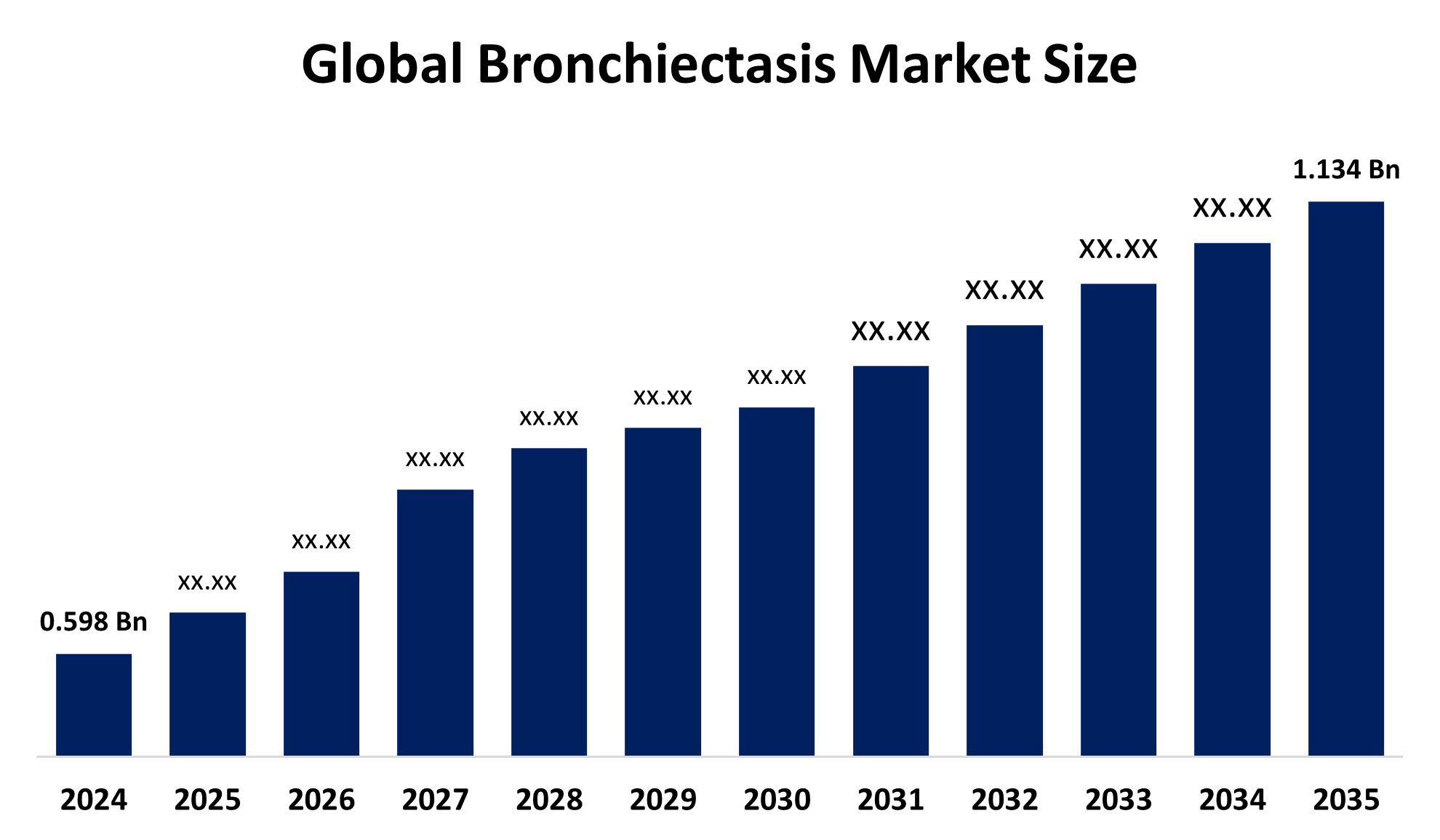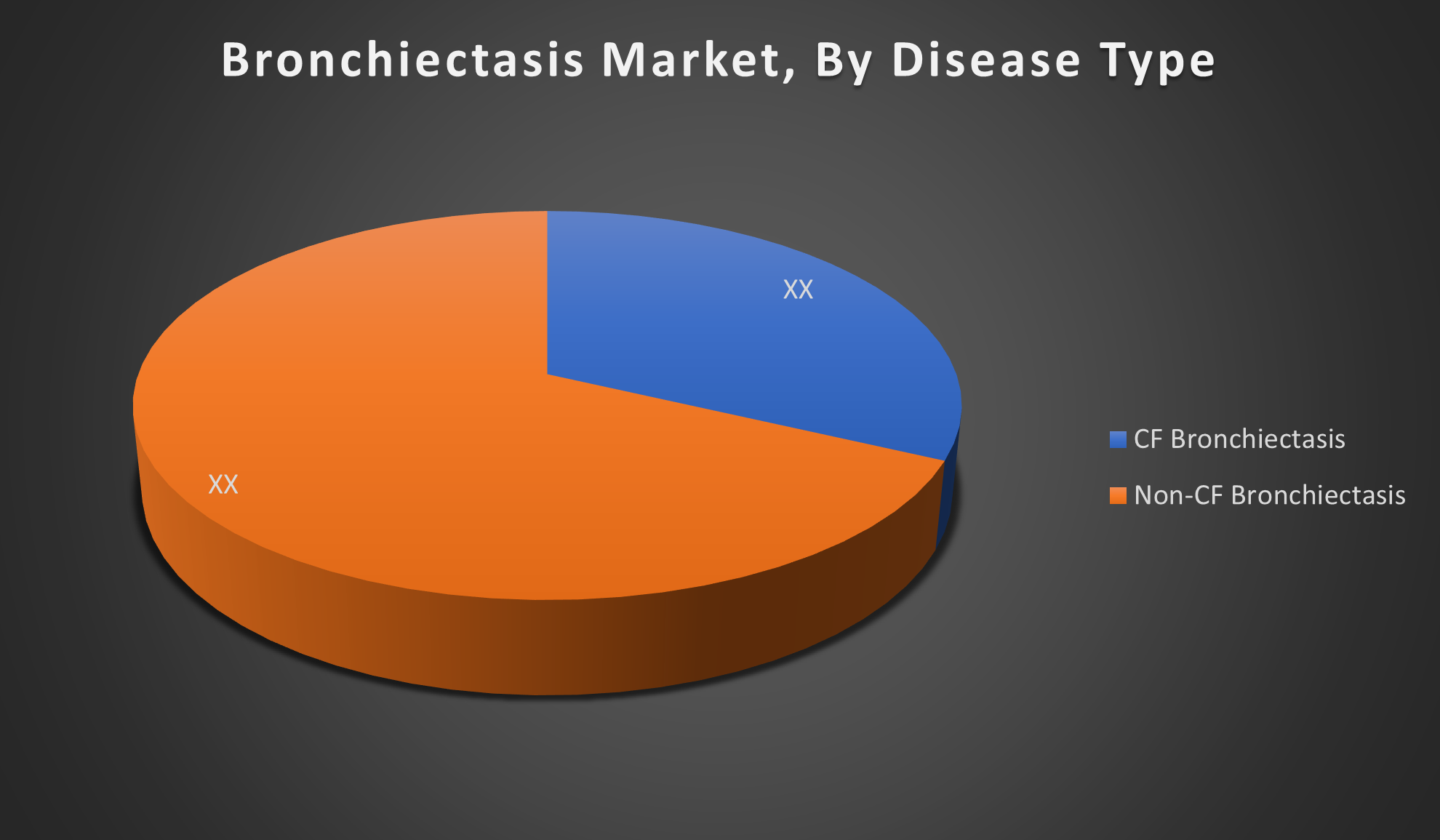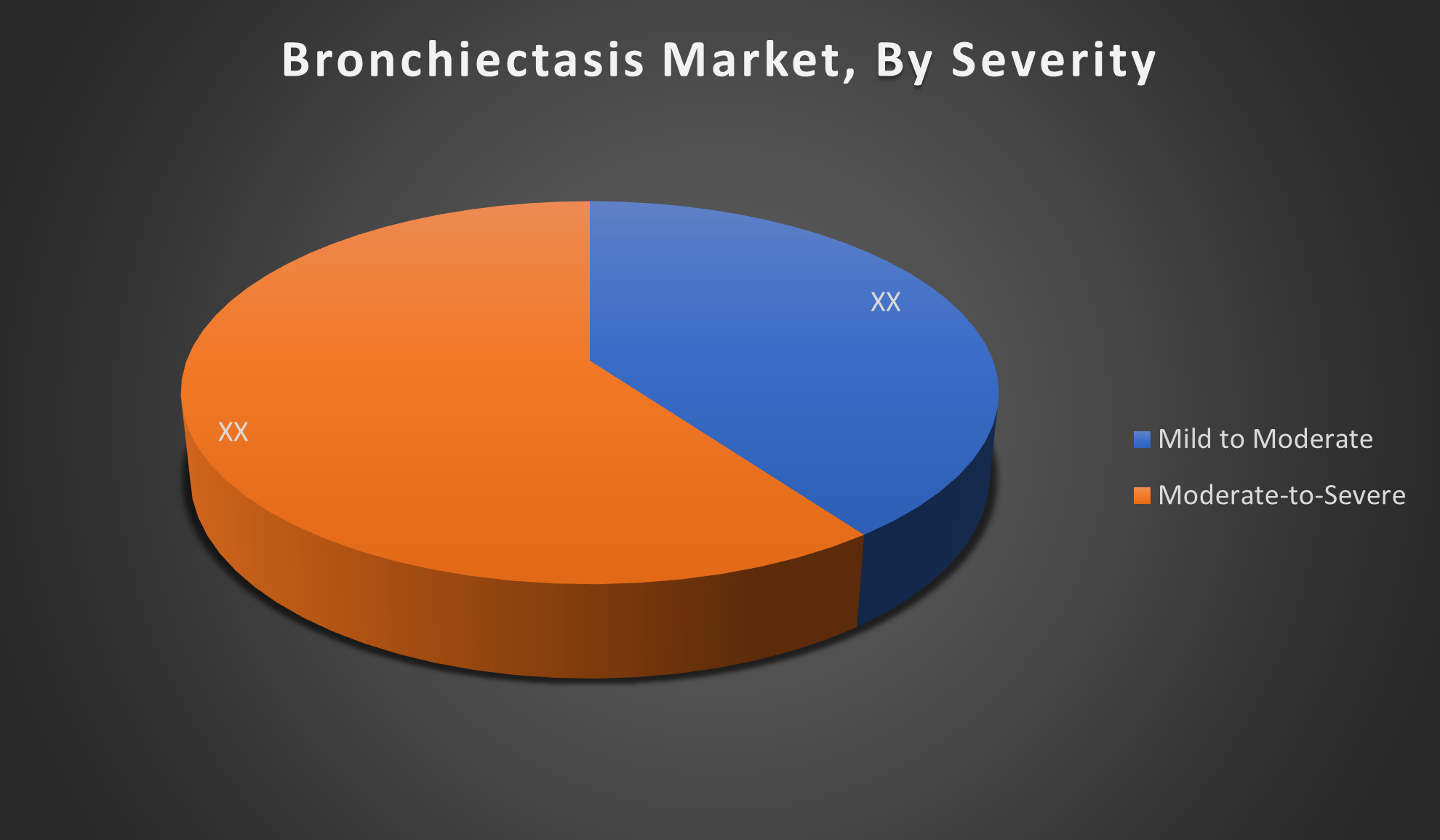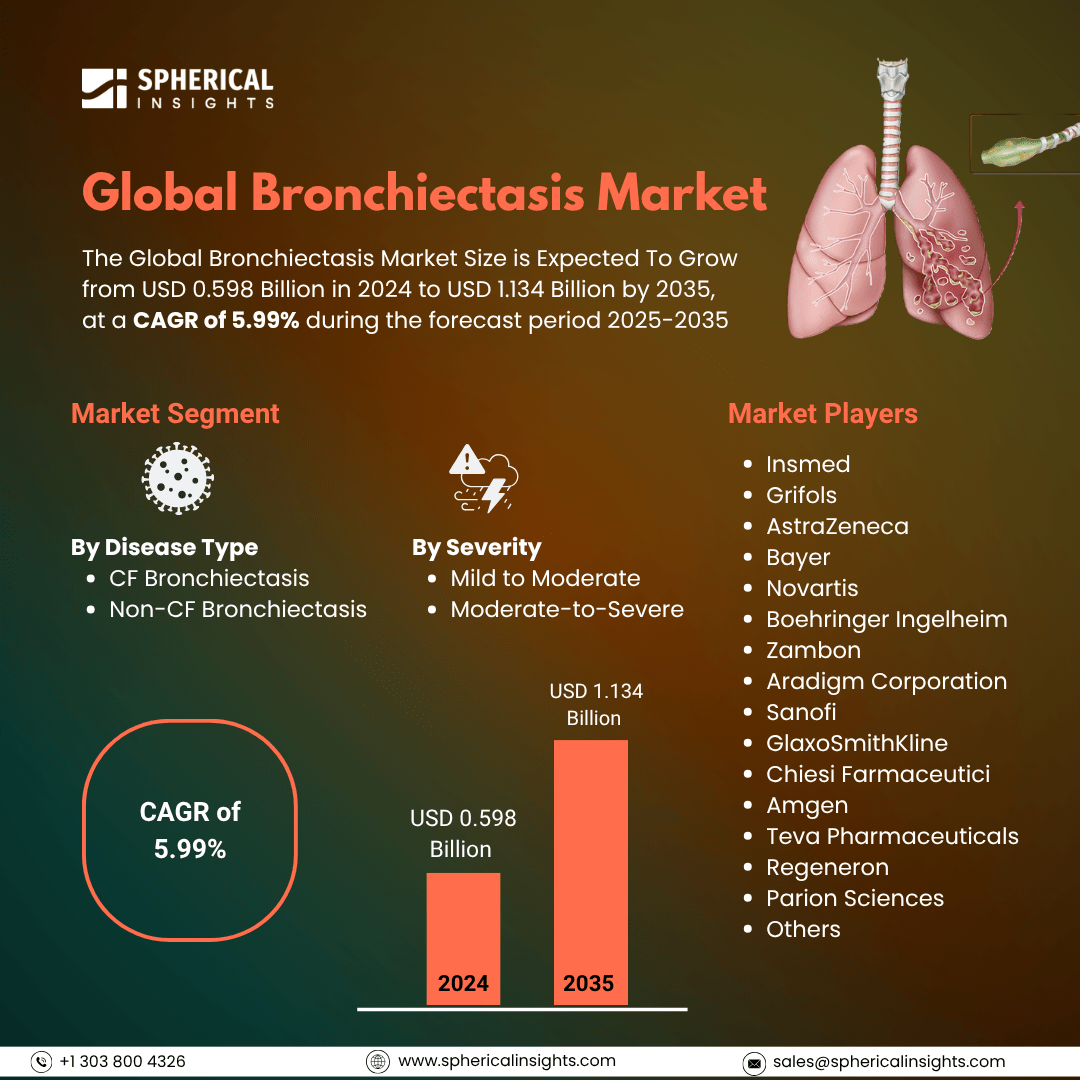- As per Spherical Insights & Consulting, The Global Bronchiectasis Market Size is expected to Grow from USD 0.598 Billion in 2024 to USD 1.134 Billion by 2035, at a CAGR of 5.99% during the forecast period 2025-2035, owing to the launch of new therapies in the market and the rise in the number of cases
- The leading Bronchiectasis Market Companies such as Insmed, Grifols, AstraZeneca, Bayer, Novartis, Boehringer Ingelheim, Zambon, Aradigm Corporation, Sanofi, GlaxoSmithKline, Chiesi Farmaceutici, Amgen, Teva Pharmaceuticals, Regeneron, Parion Sciences, and Others.

Bronchiectasis Treatment Market: Understanding and Treatment Algorithm:
Bronchiectasis includes tumors that arise in the mouth, throat, larynx, and surrounding regions. It predominantly affects men and is strongly associated with risk factors like tobacco use, alcohol consumption, and human papillomavirus (HPV) infection. Early diagnosis is crucial, as it significantly improves treatment success and patient survival.
Bronchiectasis Diagnosis:
Diagnosis of Bronchiectasis involves a combination of physical examinations, imaging tests like CT, MRI, or PET scans, and biopsy to confirm the presence of cancer cells. Endoscopy may be used to visualize tumors in the throat or larynx. Early and accurate diagnosis is essential for effective treatment planning and improved patient outcomes.
Bronchiectasis Treatment
Treatment for Bronchiectasis depends on the cancer’s stage and location and typically includes surgery, radiation therapy, and chemotherapy. Targeted therapies and immunotherapy are also increasingly used, especially for advanced cases. Multimodal approaches combining these treatments help improve survival rates and quality of life. Early diagnosis enhances the effectiveness of treatment options.
Bronchiectasis Epidemiology
The disease epidemiology covered in the report provides historical as well as forecasted epidemiology segmented by Total Diagnosed Incident Population of Bronchiectasis, Gender-specific Diagnosed Incidence of Bronchiectasis, Type-specific Diagnosed Incidence of Bronchiectasis, Age-specific Diagnosed Incidence of Bronchiectasis, Diagnosed Incident Population based on Primary Site of Bronchiectasis, and Diagnosed Incident Population based on Histologic Classification of Bronchiectasis Tumour in the global market covering North America, Europe, Asia-Pacific, Latin America, the Middle East, and Africa from 2024 to 2035.
Principal Insights
This section offers a global overview of bronchiectasis epidemiology in major markets worldwide.
Country Wise- Bronchiectasis Multiforme Epidemiology
- The epidemiology segment provides Bronchiectasis prevalence data and findings across key regions worldwide, including North America, Europe (Germany, France, Italy, Spain, and the United Kingdom), Asia-Pacific (including Japan), Latin America, the Middle East, and Africa.
Bronchiectasis: Recent Developments:
In May 2024, Insmed announced positive topline results from the Phase 3 ASPEN study of brensocatib in non-CF bronchiectasis patients. Both doses significantly reduced pulmonary exacerbations compared to placebo. The treatment was well tolerated, and Insmed planned to file an FDA New Drug Application, aiming for a U.S. launch pending approval.
Bronchiectasis Marketed Drugs:
Brensocatib is an oral dipeptidyl peptidase-1 (DPP-1) inhibitor that reduces inflammation by blocking neutrophil serine proteases. It is in advanced clinical stages for non-cystic fibrosis bronchiectasis, aiming to reduce pulmonary exacerbations and improve patient outcomes.
- Colistimethate Sodium (CMS I neb): Zambon
Colistimethate sodium is an inhaled antibiotic targeting Pseudomonas aeruginosa infections in bronchiectasis patients. It is designed to reduce bacterial load and exacerbations, with regulatory designations accelerating its development for bronchiectasis treatment.
- Fasenra (Benralizumab): AstraZeneca
Fasenra is an anti-IL-5 receptor monoclonal antibody approved for severe eosinophilic asthma and under investigation for eosinophilic bronchiectasis, aiming to reduce airway inflammation and improve respiratory function
Bronchiectasis: Emerging Therapies
- Brensocatib: It is an oral DPP-1 inhibitor currently under priority FDA review following successful Phase 3 trials. It works by blocking neutrophil elastase activation, reducing chronic airway inflammation and exacerbations in bronchiectasis. It may become the first approved treatment for non-CF bronchiectasis.
- HSK31858: It is a selective DPP 1 inhibitor in mid-stage clinical trials. By limiting the activity of neutrophil serine proteases, it aims to control inflammation and prevent lung damage in patients with bronchiectasis, similar to Brensocatib but developed independently in China.
- Gremubamab: It is a bispecific monoclonal antibody in Phase 2 development targeting chronic Pseudomonas aeruginosa colonization. It neutralizes bacterial virulence factors while modulating local immune responses, aiming to reduce bacterial load and improve lung function in infected bronchiectasis patients.
- BI 1291583: It is an oral DPP 1 inhibitor developed by Boehringer Ingelheim. It is in early-phase clinical development and aims to suppress neutrophil-driven inflammation to decrease the frequency of bronchiectasis flare-ups and slow disease progression.
Bronchiectasis Market Outlook
- The bronchiectasis market comprises diagnostics, therapeutics, and management strategies aimed at treating chronic airway dilation and infection. It includes antibiotics, anti-inflammatories, airway clearance devices, and emerging biologics. The market serves patients with non-cystic fibrosis bronchiectasis, often linked to underlying conditions like COPD, asthma, or infections.
- Growing awareness and diagnosis of non-CF bronchiectasis, rising elderly populations, and increased prevalence of chronic respiratory infections are major market drivers. Technological advancements in imaging, inhalation therapies, and increased investment in clinical research further stimulate market expansion, along with improved access to healthcare in developing nations.
- Breakthrough drugs like DPP-1 inhibitors (e.g., Brensocatib) signal a new era of targeted therapies. Opportunities also lie in personalized treatment, digital health monitoring, and partnerships in emerging markets. Expansion of inhaled antibiotic solutions and anti-inflammatory biologics presents strong potential for future commercial growth.
- Governments support respiratory health through funding research, improving air quality, and promoting early diagnosis. National health bodies and global alliances like the WHO advocate for chronic lung disease awareness and improved access to care, particularly in underserved and aging populations most affected by bronchiectasis.
- Limited disease awareness and the absence of approved therapies hinder early diagnosis and optimal treatment strategies.
- Expected to grow significantly due to rising diagnoses and breakthrough therapies targeting previously untreatable inflammatory pathways.
Bronchiectasis Market Segmentation
By Disease Type:
- CF Bronchiectasis
- Non-CF Bronchiectasis

The Non-CF Bronchiectasis segment holds the largest share in the global bronchiectasis market due to its higher prevalence compared to cystic fibrosis-related cases. It affects a broader adult population and is often linked to chronic respiratory conditions. Increasing diagnostic rates and the need for long-term treatment contribute to its market dominance.
By Severity:
- Mild to Moderate
- Moderate-to-Severe

The Moderate-to-Severe segment also leads by severity because patients in this category require ongoing management, advanced therapies, and frequent healthcare interventions, resulting in higher healthcare spending. The need for long-term antibiotic use, hospital visits, and complex care plans significantly drives market growth within this segment.
Regional Segment Analysis of the Bronchiectasis Market
North America currently holds the largest share in the bronchiectasis market due to a high prevalence of chronic respiratory conditions, advanced healthcare infrastructure, and strong clinical research funding. The presence of major pharmaceutical players and early adoption of innovative therapies, including Brensocatib, further support regional dominance. Additionally, awareness initiatives and robust diagnostic capabilities contribute to higher diagnosis rates and sustained demand for effective bronchiectasis treatments and long-term management solutions.
The Asia-Pacific region is the fastest-growing bronchiectasis market, driven by rising respiratory disease cases, increasing healthcare access, and improving diagnostic technologies. Growing elderly populations and greater awareness of chronic lung conditions are boosting demand across countries like China, India, and Japan. Government investments in respiratory health and the expansion of local pharmaceutical manufacturing are accelerating treatment availability, making Asia-Pacific a key focus for emerging therapies and multinational clinical trial activity.
Bronchiectasis Market Key Companies
- Insmed
- Grifols
- AstraZeneca
- Bayer
- Novartis
- Boehringer Ingelheim
- Zambon
- Aradigm Corporation
- Sanofi
- GlaxoSmithKline
- Chiesi Farmaceutici
- Amgen
- Teva Pharmaceuticals
- Regeneron
- Parion Sciences
- Others
Bronchiectasis Therapeutics Market Report Scope
- The Bronchiectasis therapeutics market report provides a detailed overview, covering its causes, symptoms, disease progression, and existing treatment options.
- Detailed insights into Bronchiectasis’s epidemiology and therapeutic approaches are included.
- Additionally, a comprehensive review of existing and emerging Bronchiectasis therapies is provided, including an evaluation of new treatments expected to influence the current Bronchiectasis treatment market landscape.
- The report includes a detailed review of the Bronchiectasis therapeutics market, both historical and forecasted, highlighting the global drug reach.
- The Patient-Based Bronchiectasis Market Forecasting report offers valuable insights into trends shaping the global Bronchiectasis market, helping to develop effective business strategies.
Bronchiectasis Treatment Market Report Insights
- Forecasting Market Trends Based on Patient Data and Disease Rates
- Bronchiectasis Therapeutic Approaches in Bronchiectasis
- Review Of Drugs in Development for Bronchiectasis
- Market, Growth, and Trends in Bronchiectasis
- Market Opportunities in Bronchiectasis Treatment
- Effects Of Future Therapies on Bronchiectasis Treatment.
Bronchiectasis Treatment Market Report Key Strengths
- 15 Years Bronchiectasis Market Forecast
- Global Coverage
- Bronchiectasis Epidemiology Segmentation
- Key Cross Competition
Bronchiectasis Treatment Market Report Assessment
- Present Practices in the Bronchiectasis Treatment Market
- Review of Investigational Bronchiectasis Drugs
- Attractiveness of the Bronchiectasis Drug Market
- Bronchiectasis Market Drivers
- Bronchiectasis Market Barriers
- SWOT
- Attribute Analysis
Market Segment
This study forecasts revenue at the global, regional, and country levels from 2020 to 2035. Spherical Insights has segmented the bronchiectasis market based on the below-mentioned segments:
Global Bronchiectasis Market, By Disease Type
- CF Bronchiectasis
- Non-CF Bronchiectasis
Global Bronchiectasis Market, By Severity
- Mild to Moderate
- Moderate-to-Severe
Global Bronchiectasis Market, By Regional Analysis
- North America
- Europe
- Germany
- UK
- France
- Italy
- Spain
- Russia
- Rest of Europe
- Asia Pacific
- China
- Japan
- India
- South Korea
- Australia
- Rest of Asia Pacific
- South America
- Brazil
- Argentina
- Rest of South America
- Middle East & Africa
- UAE
- Saudi Arabia
- Qatar
- South Africa
- Rest of the Middle East & Africa






